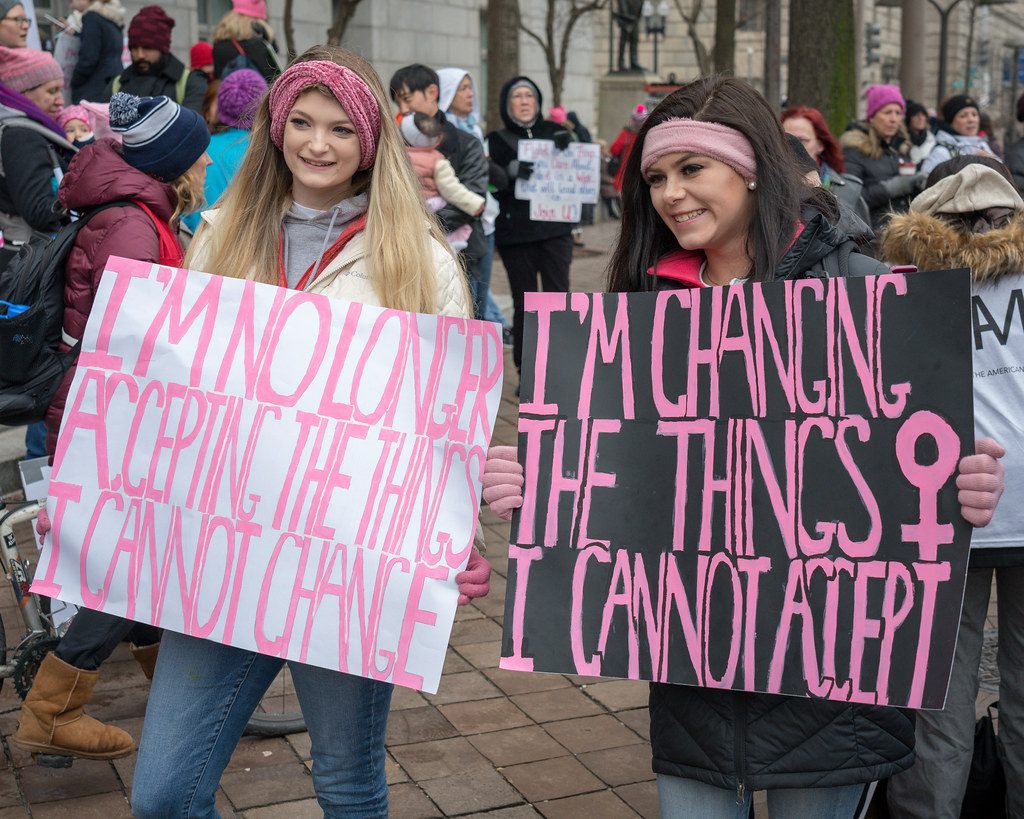 The number of single women in the U.S. has been increasing markedly. Their growing numbers, together with their very disproportionate support for Democratic candidates, should, in theory, make them a potentially powerful political force. But as a new study has shown, single women are not even taken seriously by the 471 women’s organizations that should be looking out for their interests.
The number of single women in the U.S. has been increasing markedly. Their growing numbers, together with their very disproportionate support for Democratic candidates, should, in theory, make them a potentially powerful political force. But as a new study has shown, single women are not even taken seriously by the 471 women’s organizations that should be looking out for their interests.
The author of the study, Professor Ashley English of the University of North Texas, believes that women’s groups may be hesitant to stand up for unmarried women for fear of getting labeled as anti-family. She examined a way in which those organizations could represent the interests of unmarried women while flying under the radar.
Submitting Comments to Government Agencies During the Rule-Making Process
Once a law has been passed, the details still need to be worked out in a process of rule-making. The rules are not finalized until the public has had an opportunity to comment. As Regulation Room notes, “During this time, any individual, group, corporation, or other organization can submit questions, concerns, ideas, data, and alternate proposals.” The rule-making process does not get much attention, yet it offers a way for groups to lobby for their members.
Professor English examined all the comments submitted by 471 women’s organizations between 2007 and 2013. She found that the women’s groups submitted 1,021 comments in response to 264 of the 19,562 rules that had been implemented.
She found the women’s groups in three published directories of women’s advocacy organizations – the National Council of Women’s Organizations Directory, Congressional Quarterly’s Washington Directory, and the Women of Color Organizations and National Projects Directory – and in the literature on conservative women’s organizations.
The Key Findings
- Overwhelmingly, the comments submitted by the women’s organizations focused on the concerns of married mothers. Of the 295 comments about mothers, only 7 were about single mothers.
- There were more than five times as many comments about mothers as there were about all varieties of unmarried women, combined. Even comments about married women were greatly outnumbered by comments about mothers.
- Although unmarried women have many wide-ranging concerns, when the phrase “unmarried women” showed up in the comments, the topic was always the same: reproductive rights.
- Of all the different categories of unmarried women, widows were mentioned most often in the comments. Never-married women were mentioned least often – just once.
In the next sections, I’ll describe the findings in more detail.
How Often Were Single Women Mentioned, Overall?
All mentions of single women were tallied, across these seven different phrases that were used in the comments:
- Never-married women
- Divorced women
- Separated women
- Widowed women
- Unmarried women
- Single women
- Single mothers
Single women, across all categories, were mentioned in only about 6 percent of the comments; specifically, 61 times in the 1,021 comments. Those numbers include single mothers, who were mentioned in 7 comments. Setting aside the mentions of single mothers, single women (across the other 6 categories) were mentioned in 54 of the comments, or 5.3 percent.
Surprisingly, if mentions of mothers were set aside, then married women were mentioned about as infrequently as single women. In total, they were mentioned in about about 5.5 percent of the comments. The word “wives” occurred 53 times, and the phrase “married women” occurred 3 times, for a total of 56 mentions.
The most frequently mentioned category of women, by far, was mothers. A total of 295 comments mentioned mothers, or about 29 percent of all comments. Only 7 of the 295 comments about mothers were about single mothers.
Which Categories of Single Women Were Mentioned Most Often?
Widows were mentioned most often – in 21 of the 54 comments about single women (excluding comments about single mothers). Never-married women were mentioned least often – in just one comment.
21 mentions: widows
16 mentions: unmarried women
6 mentions: divorced women
6 mentions: single women
4 mentions: separated women
1 mention: never-married women
There were also 7 mentions of single mothers.
Previously married women were mentioned in 31 of the comments (21 for widows, 6 for divorced, and 4 for separated). That’s 57 percent of all the comments about single women (excluding comments about single mothers).
When the Different Categories of Single Women Were Mentioned, What Kinds of Rules Were Being Discussed?
Which rules were the women’s organizations addressing when they mentioned the different categories of single women?
The answer is most straightforward with regard to “unmarried women.” All 16 times that phrase was used, the rule in question was about reproductive rights. Similarly, the 6 times when the phrase “single women” was mentioned, the rules were about birth control and contraception at least some of the times. (The author did not say whether the rules were about that topic all 6 times.)
Widows were mentioned in comments more often than any other category of single women (21 times). The rules addressed by the comments were wide-ranging and included:
- Health plans for military service members and their families
- Family visitation rights in hospitals
- Survivor’s annuities in retirement plans covered by the Employment Retirement Income Security Act (ERISA), and
- Income verification procedures for widows who apply for housing programs in the Department of Housing and Urban Development
The 7 comments about “single mothers” were also addressing a variety of rules, including rules about:
- The ACA’s (Affordable Care Act) high-risk insurance pools
- The FMLA (Family and Medical Leave Act)
- ICE’s policy regarding no-match letters for employment verification
- Gender wage discrimination
- Payment options available in the ACA
The author mentioned just one of the kinds of rules addressed in the 6 comments about divorced women: regulations for ERISA retirement plans, relevant because of the risk of economic vulnerability faced by this group. She also mentioned just one of the kinds of rules addressed in the 4 comments about separated women: rules relevant to the challenges they face when filing joint tax returns to claim the ACA health insurance credit.
The 1 and only comment mentioning “never-married women” was about retirement: “never-married women are especially vulnerable in retirement … and 18% of never-married elderly women lived in poverty.” As Professor English noted:
“Given that 96% of never-married women are between the ages of 18 and 64, it is remarkable that the only time they were mentioned in seven years of women’s organizations’ comments was in response to a rule about ERISA retirement policies!”
How Often Were Single Women Mentioned in the Rules that the Organizations Were Addressing?
In addition to examining the comments, Professor English also analyzed the wording of the rules. She found that none of the 264 proposed rules explicitly mentioned single women. That, in itself, seems significant. But could it account for the small number of comments about single women? The author looked at whether the rules targeted wives and whether they targeted mothers. She found it didn’t matter – the same small number of comments about single women were submitted, regardless.
What Do the Results Say about How Single Women Are Regarded by Women’s Organizations?
When they mentioned “unmarried women” or “single women” in their comments, the women’s organizations focused almost exclusively on issues of reproductive rights, such as abortion and contraception. Those issues are important to many unmarried women but not all of them. Many other matters are important to these women. For example, single women typically do not have an income from a partner to fall back on, and they are economically disadvantaged in many other ways as well. That means that issues such as decent wages, equal pay, affordable college education, and affordable healthcare may be of particular concern to them.
The women’s organizations realized that coverage under the Family and Medical Leave Act (FMLA) was of special concern to single mothers but did not seem to recognize that it is also of consequence to unmarried women who are not mothers. FMLA allows married women to take time off to care for a spouse, but unmarried women cannot take time off to care for a peer who may be especially important to them, such as a close friend or relative. Nor can any such person take time off under FMLA to care for the unmarried woman. Other issues, too, that the organizations recognized as relevant to, say, widows or single mothers, are also of interest to other unmarried women, but were not acknowledged as such.
The obvious problem is that the women’s groups are falling short in their advocacy of the interests and concerns of unmarried women – especially those who have never been married. But the problems go beyond that. As Professor English noted, “this narrow focus on unmarried women’s sex lives risks reinscribing negative stereotypes that unmarried women are selfish and/or promiscuous.”
Why Is This Happening and What Can We Do About It?
English notes that women’s groups have long focused on the concerns of married mothers and marginalized single women. That can set up a self-perpetuating dynamic:
“…when single women encounter a large number of social policies that provide married couples with benefits, but that do not help them, they may choose not to participate in politics, and women’s organizations may focus on their more politically active married counterparts instead.”
Women’s organizations may be ignoring single women strategically, English believes, in order “to proactively defend their organizations against criticisms that they are antifamily.” I wonder, though, about another possibility: maybe, in some instances, it never even occurs to the leadership of those organizations to stand up for single women.
The most important reason unmarried women are underrepresented in the organizations’ efforts, or reduced to stereotypes, may be this: none of the organizations explicitly represented single women. Professor English could not find even one women’s organization looking out specifically for them.
She concluded:
“…for single women to become politically powerful, they will need more than just large numbers; they may also need niche organizations that can help them organize and articulate their broader policy needs.”
Reference:
English, Ashley. (2019). Where are all the single ladies? Marital status and women’s organizations’ rule-making campaigns. Politics & Gender. [accessed online; as of August 1, 2019, the article had not yet appeared in print]
[Notes: (1) The opinions expressed here do not represent the official positions of Unmarried Equality. (2) I’ll post all these blog posts at the UE Facebook page; please join our discussions there. (3) For links to previous columns, click here.]



